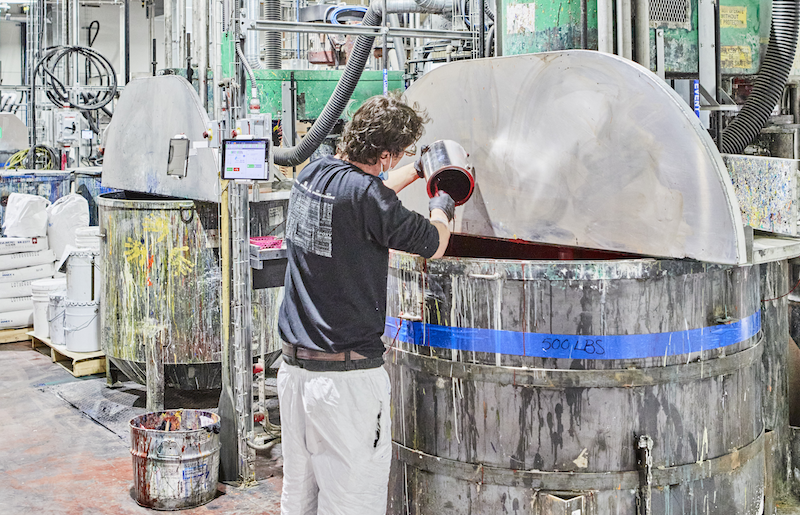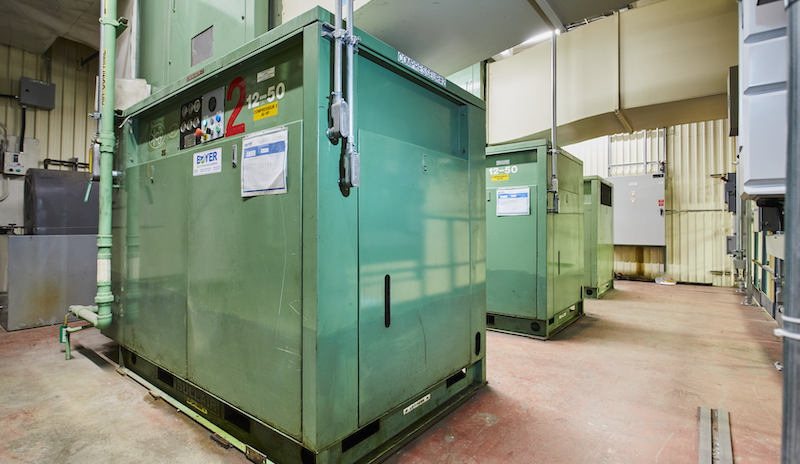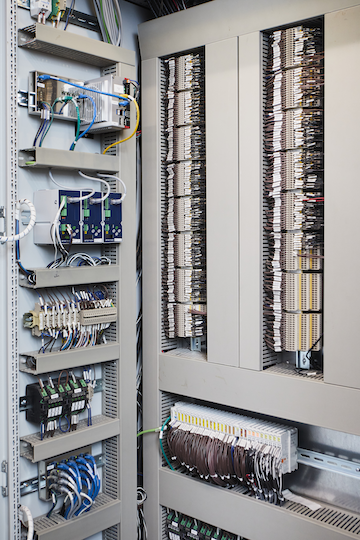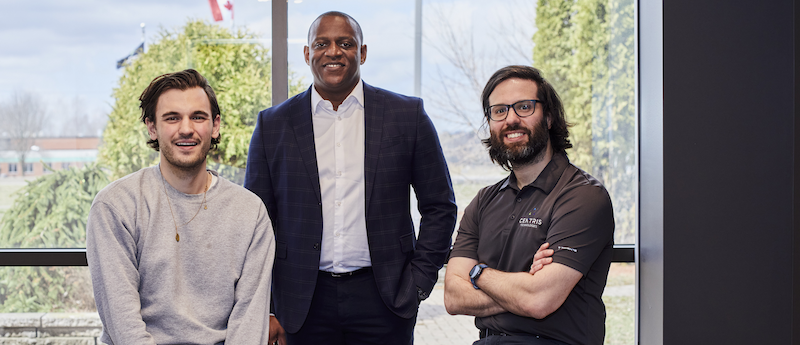
A Fresh Coat
By James Figy
Automation Motion Control Machine BuildingQuebec-based paint manufacturer, Pépin Industries, leverages digital transformation to boost throughput 150%.

Since the automation upgrades, operators at Pépin Industries spend less time hunting down materials, each process step is monitored and order accuracy has improved dramatically.
(© Pierre Charbonneau, 2022)
Since 1958, Pépin Industries Ltd. has provided solvent-based industrial paints with incredibly short turnaround times. By industry standards, its batch sizes may be considered small – typically several hundred gallons – but this approach allows customers to order what they need, when they need it. In the past, however, lingering manual processes limited order traceability, efficiency of plant staff and, as a result, the company’s ability to scale.
When Pépin Industries was moving to a new facility in Cowansville, Quebec, the family-owned company turned to system integrator, Centris Technologies, to digitally transform its operations with innovative automation and IIoT solutions.
“Centris was a great help in the success of our automation project – and still is as we implement a new ERP system,” says Francis Pépin, Director of Operations at Pépin Industries. “They helped with many aspects of the process that had stumped us and other engineering firms. Through their experience with other paint companies, they understood our needs and presented the right solutions very quickly.”
Chipping away at profitability
Pépin Industries wanted the technology update to increase accuracy and transparency, as well as throughput. Issues in these areas had persisted prior to the implementation, says Pépin Industries’ Production and Lab Director, Hélène Daigle.
“In the past, our highly manual process made it difficult to track everything that went on during production,” she explains. “The operators had work orders, but it was hard to tell how closely they followed the steps and ingredient quantities during the mixing process.” This led to rework of paint that didn’t pass quality inspection or throwing out a batch due to poor coloring, incorrect ingredient mixtures, contamination, etc.
The lack of digital records made it tough to determine what happened and correct the issue going forward. This is where Centris stepped in. The Centris engineering team uses its IT and automation technology expertise to implement Industrie 4.0 and IIoT concepts, including increased traceability, machine monitoring, predictive maintenance and more.

EtherCAT networks a wide variety of devices, including these compressors, while gateways allow for simple integration of components over EtherNet/IP and BACnet.
(© Pierre Charbonneau, 2022)
Applying a fresh coat
Pépin Industries’ new production facility features six bulk tanks for the most common paint ingredients and additional totes for a variety of others, including additives, resins, sands, etc. The automated system designed by Centris transfers materials from the tanks and totes to the correct mixing station, and it replenishes tanks from incoming shipments. The system controls temperature and pressure while monitoring ingredient levels and other factors. As such, it ensures there is enough of each ingredient and that they remain viscous enough during transfer.
In the past, operators had to push around large vats and measure out ingredients by hand before mixing, but now they initiate and manage the processes at each mixer. Tablets – either handheld or mounted on the workstation – offer simple control, insights and alarms when needed, while Beckhoff’s C6030 IPC serves as the central controller.
“Beckhoff Industrial PCs are very powerful and offer fast cycle times,” says Marc-André Duguay, Industrial Software Developer at Centris. “It’s easy to access data, and the programming and troubleshooting are simple in TwinCAT software, especially with structured text.”
The openness and secure connectivity of Beckhoff PC-based control enables communication with the Centris-developed SCADA via OPC UA. It also simplified integration of the plant’s local network via TCP/IP, which facilitates communication between the controller and the tablets on the plant floor.
The continuing ERP upgrade will also benefit from the technologies’ OT-IT convergence. As such, it boosts collaboration between Centris’ automation engineers and industrial software experts, empowering the digital transformation at Pépin Industries.

Beckhoff’s C6030 IPC and a range of EtherCAT solutions power the automated paint production system implemented by Centris Technologies.
(© Pierre Charbonneau, 2022)
Networking the plant together
The EtherCAT industrial Ethernet system provides field-level communication. ELX series EtherCAT terminals from Beckhoff deliver invaluable intrinsic safety at the paint plant. The ELX system allows for a wide range of intrinsically safe terminals to reside in the same segment with standard I/O.
The ELX approach also eliminated the costs and labor requirements for additional explosion-proof enclosures, barriers and the bus couplers needed to link to remote segments when compared to the traditional approach to intrinsic safety.
“EtherCAT is also very easy to configure: We just connect the I/Os, click ’Scan’ and it finds all of the nodes,” Duguay adds. Centris leveraged numerous IP20-rated EL series EtherCAT I/O terminals and TwinSAFE integrated safety terminals from Beckhoff. Remote segments connected via EK1100 EtherCAT couplers communicate to pneumatic valves, large compressors, variable-frequency drives for mixing paints and other devices.
EtherCAT supports up to 65,535 nodes on a single network, processing on the fly and free selection of topology, including line, star, tree and others. Ring topology, in particular, provides the necessary cabling redundancy for the Centris system, according to Duguay.
In addition, the open Ethernet fieldbus simplifies multi-vendor architectures. Beckhoff provides gateways and bus couplers to more than 30 prominent communication protocols for this purpose. The Beckhoff CU2016 16-port Ethernet switch, for example, easily incorporated scales for measuring raw materials over EtherNet/IP.
TwinCAT can also enable communication to other protocols, such as the gas detection and ventilation system on BACnet that plugs into the C6030 with a standard RJ45 connector. The simple integration of building automation technology into a standard industrial automation system allows the customer to see all ventilation information in the SCADA, Duguay explains. “If chemical fumes reach certain levels, it’s very dangerous,” she says. “The plant has alarms to protect operators, but this [SCADA] provides additional critical information.”
Impressive results
The digital transformation at Pépin Industries increased throughput by more than 150%. “With the new system, we increased production from eight batches per day to 12 batches per day – some days, as many as 15 – and our average batch size increased from 180 gallons to 300 gallons,” Francis Pépin reports. “Our output is much greater due to the technology updates from Centris, and we have the potential to grow much more.”
The industrial paint producer also achieved greater transparency while optimizing production scheduling and its ability to analyze and improve processes based on actionable data insights. Increases in accuracy have greatly reduced post-production adjustments and material waste.

From left: Francis Pépin, Director of Operations at Pépin Industries; Ted Sarazin, Regional Sales Manager at Beckhoff Canada; and Martin Legris, Project Manager/Developer at Centris Technologies.
(© Pierre Charbonneau, 2022)
“Having better control of the production process allowed us to decrease our number of batches put in rework from two to three per month to just one per quarter,” Daigle says. “Our workers spend less time looking for raw material in the warehouse as most ingredients for a batch are either pre-weighted or come from the automated system.”
For Centris, the use of PC-based automation and EtherCAT technologies continues to enhance the team’s capabilities and efficiency in a wide variety of projects. Commissioning times have accelerated since the company’s transition to Beckhoff, even in complex systems.
“Having Beckhoff as our main control platform partner is reassuring, since they remain on the leading edge of automation and continue to enhance their technology offerings,” says Centris Technologies founder, Michel Kakos. “Beyond the technology benefits, it’s always a pleasure to work with the local team.”
This extends through the design process to support and application engineering assistance. Duguay sees the reliable support from Yan Letourneau, Application Specialist at Beckhoff Canada, and others as exemplary. “We receive excellent technical advice from Yan, and on projects in the U.S., the support from Beckhoff USA is the same high quality.”
Like a perfectly produced batch of paint, the collaboration between Centris and Beckhoff has combined all the right ingredients for an ideal mix.
www.centristech.com
www.pepincoatings.com
www.beckhoff.com
James Figy is the senior content specialist at Beckhoff Automation.
